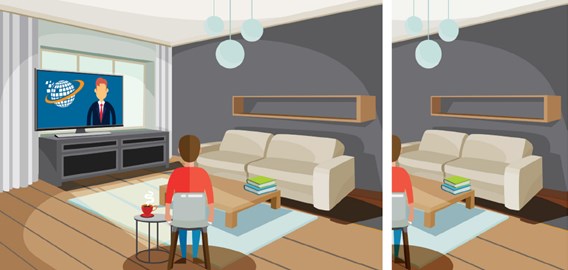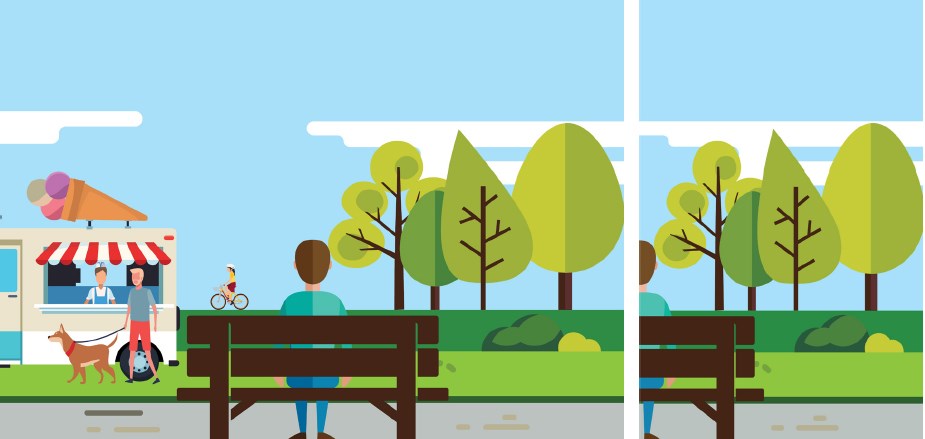Den här webbplatsen använder cookies, som samlar information om hur du interagerar med sidan. I kombination med de uppgifter du uppger, skapar vi en profil så att vi ska kunna visa relevant innehåll just för dig. Genom att acceptera tillåter du att vi samlar och behandlar dina personuppgifter enligt beskrivningen.
Left-sided inattention
To perform tasks in everyday life, we need to be able to pay attention to everything that is happening around us. Our attention needs to be distributed across the entire field of attention. To be able to move safely and effectively, we need to be aware of where our body is positioned in relation to our surroundings.
What is left-sided inattention?
In the brain, the right side controls the left side of the body and vice versa. Left-sided inattention, sometimes referred to as neglect, usually occurs when there is an injury to the right parietal lobe. Approximately half of the people who experience a right-sided brain injury show signs of left-sided inattention during the initial weeks after their injury. Most of the time the symptoms resolve, but for some people it may affect them for the rest of their life. Injuries to the left side of the brain can also lead to inattention to the right side. This is less common, resolves faster and leads to less difficulties.
Left-sided inattention means an inability to automatically pay attention to information from vision, hearing and feeling to the left side. The difficulty in perceiving the information usually increases the further out to the left side the source of information is. The person has difficulty perceiving their body and the space surrounding it. It is not the person’s ability to see, hear or feel sensations that is compromised. Rather, it is the brain’s ability to pay attention to sensations, noises and objects (through vision) that is impaired.
In the case of left-sided inattention, the person’s perception is impaired. However, for these people their motor skills and self-awareness are usually also damaged.

Perception
The person does not, with his or her senses, notice the information from the left side of the attention field. For example, in traffic, it could mean the person with left-sided inattention does not pay attention to a vehicle approaching from the left through their sight or hearing.
Movement
The person does not use his or her motor skills to their full capacity. He or she is completely or partially inactive in the left half of the body. For example, they only pick up objects with their right hand even though their left hand is capable of moving functionally.
Self-Awareness
The person’s ability to understand his or her limitations and the day to day impact of such limitations is impaired. This is common in all right sided brain injuries and leads to overestimation of his or her abilities. The person therefore doesn´t understand the benefits of using strategies or aids, as it does not feel necessary.
Why does left-sided inattention occur?
Each side of the brain, left and right, function differently when it comes to perceiving and processing sensory information. The right side perceives information from both the right and left of our environment. The left hemisphere is more specialised and perceives mostly sensory information from the right side. When a brain injury occurs in the left hemisphere, the right side of the brain can compensate for the damaged left side to perceive information on the right of our environment. However, the left side of the brain cannot compensate for the damage to the right side.

Illustrations showing normal visual attention outdoors and left-sided visual inattention outdoors.
What are the consequences of left-sided inattention?
The impact on day to day life for people with left-sided inattention can vary significantly. For some, everyday activities are difficult to execute. It can be difficult to get dressed and take care of personal hygiene independently. Difficulty with familiarising themselves in a new environment is also common. Tasks such as reading and eating can be difficult because words and food on the left side go unnoticed. The person’s lack of awareness of their inattention difficulties can lead to dangerous situations. This is due to the lack of ability to safely detect warning signals which puts them at an increased risk of accidents in the community and at home. As a result of this people with left-sided inattention are often dependent on support from other people to cope with their everyday lives.
What can be done?
Assessment
Assessment is beneficial to determine the day to day difficulties and risks the person may experience. Assessment is made by observing the person in everyday life and clinical assessment.
Remediation therapy
For treatment of left-sided inattention to be successful, the person needs to have selfawareness of their inattention. When aiming to remediate a left-sided inattention, the focus of treatment is to increase the attentiveness or consciousness of sensory information to the left side. The purpose of this approach is for the person to develop a habit of shifting their attention to the left. Developing this behavior will initially be a very conscious and deliberate effort but after consistent and repetitive practice it can become an unconscious behaviour (habit).
This can be trained with teaching strategies from another person, placing bright markers on the left side of a computer and table area as well as ruling red lines in the left margin of a text. Additionally, if scanning to the left side is combined with trunk rotation it has been shown to have a greater effect. Prism glasses, which move the field of vision to the left, can also improve the ability to pay attention to the left. Intensive motor training with left side of the body has also reduced the impact of left-sided inattention in some cases.
Compensatory strategies
Several different compensatory strategies can be used to improve the ability to notice leftsided information and, in turn, increase safety and the person’s independence in day to day life. Here are some strategies used.
Strengthening of information
This strategy aims to help information from the left side compete with the information from the right. For example to avoid collisions with a door frame, clearly mark the left side with a red warning sign.
Moving information in the room
Important information is placed where the person can easily perceive it. An example, spinning the plate so leftovers end up on the right side and can be more easily recognised.
Reduce information
For a person with left-sided inattention the information from the right side can drown out information from the left. By reducing the information on the right side, the possibilities to pay attention to stimuli or sensory information on the left side can be increased. Covering the right eye or right side of the visual field on both eyes increases attention to the left.
Another person reminds
Another way is for another person to consistently and actively remind the person to move attention to the left.
Exchange of information type
When the task of finding text in books, magazines and computer monitors becomes too demanding, then audio books and ‘text to speech’ technology can facilitate information retrieval.
Individualised assistance and support
It is common for a person with left-sided inattention to also have other impairments which may be more obvious, such as profound mobility difficulties or being unable to verbally communicate. It is important that support is designed to compensate for all the person’s disabilities, including their left-sided inattention and its impact on their day to day life.
Reviewed by:
Björn Johansson, MD, PhD, Consultant, Department of Rehabilitation Medicine, Uppsala University Hospital, Sweden.
Lars Eriksson, Psychologist, Rehabilitation and Pain Centre, Uppsala University Hospital, Sweden.
Curtis Reddell, Rehabilitation Coordinator, Brightwater Care Group, Perth, Western Australia.
Illustration: Brightwater Care Group Limited.
Version: April 26, 2021
Infotekets övriga faktatexter om förvärvade hjärnskador
Här på Infotekets webbplats kan du också läsa:
- Arbetsminne och hjärnskada.
- Att leva med förvärvad hjärnskada.
- Förvärvade hjärnskador.
- Minne och hjärnskada.
- Långtidsminne och hjärnskada.
- Vad är hjärnskakning?
- Vad är kognitiva svårigheter och vad kan underlätta?
- Vänstersidig ouppmärksamhet.
Faktatexter på Lättläst svenska:
Faktatexter på engelska - In english: